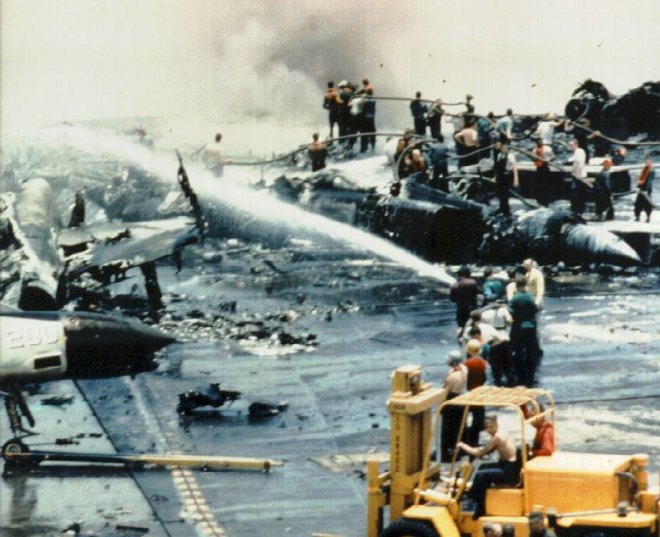In the USS Foreestal indicent, 134 crewmen were killed and 161 seriously injured. There were nine large explosion from 1000 lb and 500 lb bombs which blew through the flight deck and showered burning fuel into berthing spaces and into the hangar bay.
It started at 1050 (local time) while preparations for a second strike against North Vietnam were being made. An unguided 5.0 in Mk-32 "Zuni" rocket on an F-4B Phantom II, was accidentally fired due to an electrical power surge during the switch from external power to internal power.
The rocket flew across the flight deck, striking a wing-mounted external fuel tank on an A-4E Skyhawk awaiting launch. The Zuni Rocket's warhead safety mechanism prevented it from detonating, but the impact tore the tank off the wing and ignited the resulting spray of escaping JP-5 fuel, causing an instantaneous conflagration. Within seconds, other external fuel tanks on aircraft overheated and ruptured, releasing more jet fuel to feed the flames, which began spreading along the flight deck.
The impact of the Zuni had also dislodged two of the 1,000 lb bombs which lay in the pool of burning fuel. The fire team's chief, Gerald Farrier immediately smothered the bombs with a PKP fire extinguisher in an effort to knock down the fuel fire long enough to allow the pilots to escape. The pilots, still strapped into their aircraft, were immediately aware that a disaster was unfolding, but only some were able to escape in time.
According to their training, the fire team normally had almost three minutes to reduce the temperature of the bombs to a safe level, but the chief did not realize taht the bombs were already critically close to cooking-off until one of them split open. On seeing this, the chief, knowing a lethal explosion was imminent, shouted for the fire team to withdraw but the bomb exploded seconds later – a mere one and a half minutes after the start of the fire.
The detonation destroyed several aircraft with their remaining fuel and armament, blew a crater in the armored flight deck, and sprayed the deck and crew with bomb fragments and burning fuel. The on-deck firefighting contingent took the brunt of the initial blast; all were killed instantly with the exception of three men who were critically injured but ultimately survived.
Sailors and Marines controlled the flight deck fires by 1215, and continued to clear smoke and to cool hot steel on the 2nd and 3rd levels until they were under control by 1342. But the overall fire was not declared completely defeated until 0400 the next morning, (18 hours) due to additional flare-ups
Ultimately 21 aircraft were destroyed, with the loss of life and injuries mentioned above.
Here's how it looked during the fir and explosions:
Here's how the carrier looked right after the incident:
And here's the Forrestal a month later, sailing back towards the US:
Very reminiscent of things like the USS Enterprise, CV-6 went through in World War II.



